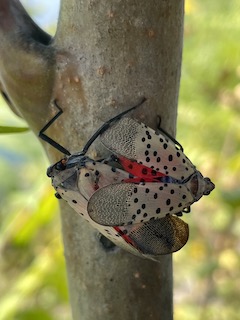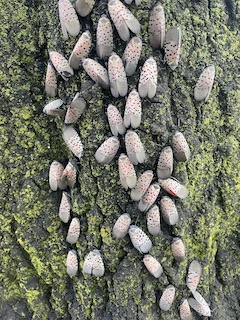From Central Park to the laboratory, Fordham students are examining the mating behavior and predators of the little-understood bugs.
Andrea Dickantone and Clyde Skillin have spent a month poking around Central Park studying those red and black bugs that New Yorkers are accustomed to seeing squashed, hopping on sidewalks, or clustered along the walls of buildings. They are studying spotted lanternflies’ courting behavior, which hasn’t been well-studied so far.
“I thought it was very cool and current and wanted to be part of it,” said Skillin, a sophomore environmental studies student at Fordham College at Lincoln Center.
He and Dickantone are among eight Fordham students hoping to find answers to several questions about the bugs that no one seems to know yet: How often do they mate? Are squirrels making meals out of them? Why are they attracted to certain types of city buildings and not others?

These answers could help point to ways to control the invasive species, their professor said.
Ellen van Wilgenburg, Ph.D., assistant professor of biology in the Department of Natural Sciences at Fordham College at Lincoln Center, is spearheading the research and teaching the students scientific methods to collect data that can be used in larger studies of the lanternflies. So far, existing research has focused more on the agricultural impact than the behavior of the species.
“It’s pest management and applied research, which is very important work,” she said. “But I think behavioral ecology is also important and can help with pest management, too.”
Dickantone, a senior neuroscience major, and Skillin have now begun dissecting the insects under the microscope to see how many spermatophores, or sperm packets, the female insects have in their abdomens to determine how many times they have mated. They also have recorded videos of the courtship process showing the males vibrating their wings rapidly and stroking the females in an effort to attract them.
Each female lays 30 to 50 eggs in masses on trees. They are currently at that egg-laying phase of their life cycle; they will die off in November and December.
“You would expect species that are introduced and encounter a novel environment would mate [more than once],“ to help the species survive, van Wilgenburg said, and the students are trying to determine if that is the case with the lanternflies.
Little Calorie Bombs
Another team of students has been collecting squirrel feces and looking for molecular markers that would indicate a developing taste for lanternflies. They have witnessed squirrels eating the insects in the park. This is significant because the species has few known predators, most likely helping its rapid population explosion.
“Actually they are not very tasty,” van Wilgenburg said. “Supposedly they are very bitter.” She said the trees the lanternflies prefer contain quassinoids, compounds that make them unpalatable to most insect-eating animals. “Squirrels eat acorns, which are also bitter, so maybe.”
Van Wilgenburg added, “Females, especially when full of eggs, must be little calorie bombs and full of nutrition.”
How High?
Another group of students in her Global Ecology Lab looked at what features on buildings attract lanternflies. There have not been any published studies looking into this, but several researchers have speculated that the lanternflies confuse tall buildings for trees. Van Wilgenburg said her students’ data showed height doesn’t matter. What they found does matter is if a building has a lot of glass on its lower floors.

She said she wants to look at it further, perhaps next year, and collect more data. “Could it be UV light wavelengths? Maybe we could find something that could work as traps.”
Spotted lanternflies are native to China, where they are kept in check by a parasitic wasp. In the U.S., they were first detected in Pennsylvania in September 2014 while they were mostly feasting on another invasive species, the Tree of Heaven. They have caused a great deal of alarm among state agriculture departments.
But since then, as they have multiplied and migrated and developed a taste for other plants, scientists are realizing the bugs don’t do a terrible amount of harm other than being an annoyance, van Wilgenburg said, noting that fruit trees and vineyards are the only agricultural species of concern.
To Stomp or Not to Stomp?
So what about the trending effort to try stomping them out?
Thirty-five percent of them at relevant life stages—mainly egg masses—would need to be killed to start lowering the population growth, van Wilgenburg said, citing a study from 2021.
“Stomping on them is not going to help.”


